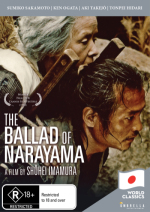Ballad of Narayama (Narayama-bushi kô) (1983) |
|
Ballad of Narayama (Narayama-bushi kô) (1983) |
|


|
| BUY IT |
| General | Extras | ||
| Category | Drama | Theatrical Trailer | |
| Rating |

|
||
| Year Of Production | 1983 | ||
| Running Time | 129:47 (Case: 132) | ||
| RSDL / Flipper | Dual Layered | Cast & Crew | |
| Start Up | Programme | ||
| Region Coding | 1,2,3,4,5,6 | Directed By | Shohei Imamura |
|
Studio
Distributor |
 Umbrella Entertainment |
Starring |
Ken Ogata Sumiko Sakamoto Tonpei Hidari Aki Takejo Shoichi Ozawa Fujio Tokita Sanshô Shinsui Seiji Kurasaki Junko Takada Mitsuko Baisho Taiji Tonoyama Casey Takamine Nenji Kobayashi |
| Case | Amaray-Opaque | ||
| RPI | ? | Music | Shinichirô Ikebe |
| Video | Audio | ||
| Pan & Scan/Full Frame | None | Japanese Dolby Digital 2.0 mono (192Kb/s) | |
| Widescreen Aspect Ratio | 1.78:1 | ||
| 16x9 Enhancement |
 |
||
| Video Format | ? | ||
| Original Aspect Ratio | 1.85:1 | Miscellaneous | |
| Jacket Pictures | No | ||
| Subtitles | English | Smoking | No |
| Annoying Product Placement | No | ||
| Action In or After Credits | No | ||
In a remote village, high in the mountains of Japan, life is harsh and food, especially in the winters, scarce. To control population, and thus mouths to feed, only the first born son is allowed to marry and have children, second and subsequent sons are either exposed as babies or, if let live, kept around to work, girl babies are often sold and families found stealing food from others in the village can be buried alive. And, finally, when a villager turns 70 they are required to be carried by their eldest son up into the mountains and left to die.
Orin (Sumiko Sakamoto) is approaching 70 but, unlike some of the other elderly people, is rather looking forward to being carried up the mountain next winter by her oldest son Tatsuhei (Ken Ogata), a widower. But first, as head of the family, her husband having disappeared many years before, Orin has a few tasks to complete. The first is to find a new wife for Tatsuhei, and Tamayan (Aki Takejo), a homely woman who has recently been widowed, is sourced from a neighbouring village. Second, she has to deal with Tatsuhei’s eldest son Kesakachi (Seiji Kurasaki) who has made village girl Matsuyan (Junko Takada) pregnant. Finally, she wants to find somebody, anybody, willing to have sex with her unattractive, and very smelly, virgin second son Risuke (Tonpei Hidari). When matters are resolved, Orin takes a final, silent journey, carried on Tatsuhei’s back, up onto the mountain to die.
The Ballad of Narayama (Narayama Bushiko) is based on two of the stories by Shichiro Fukazawa. The stories had been filmed in Japan before, in 1958 by writer / director Keisuke Kinoshita; this version by writer / director Shohei Inamura is a stunning work that won its director the Palme d’Or at Cannes in 1983 (Inamura picked up another Palme d’Or in 1997 for Unagi). The Ballad of Narayama is at times a dark film reflecting the harsh life of the people in the isolated village, but this is leavened somewhat by the fact that it is also a darkly funny film with things to say about customs, law and tradition, sex, family, life and death. It is beautifully filmed, contrasting the idyllic snow covered mountains and verdant forests with life in the village. Inamura always ensures that we know that these environments contain not only the humans for he frequently cut to birds, insects, rodents and other mammals as well as snakes, all mating and feeding, showing that the humans are only a part of life in these mountains; a scene of an eagle that swoops down and carries away a rabbit that has just been chased and shot by Tatsuhei is black humour at its best, and rather typical Inamura.
The Ballad of Narayama, given the subject matter, could be a depressing film but the black humour, stunning cinematography, natural ensemble acting including a wonderful performance by Sumiko Sakamoto results in a film that is life affirming, more about life going on than death in a mountain village.
The Ballad of Narayama is in the 1.77:1 aspect ratio; it is NTSC, region free and 16x9 enhanced.
The Ballad of Narayama takes place over one cycle of seasons, starting and ending in winter. Thus, vision of the snow covered mountains and valleys and of the village blanketed by snow starts and finishes the film; in between there are bright spring colours, the greens of the trees and growing crops in summer, the beautiful autumn colours. Close-ups are strong and exterior scenes also have very good detail; the interiors and the night sequences are another matter and do look soft with indistinct shadow detail. Nevertheless, blacks are solid, skin tones natural, contrast and brightness consistent. Other than a very occasional tiny fleck I did not notice any marks or artefacts.
English subtitles are provided in a clear white font which can be removed via the remote. They are easy to read, except for a few times when they flashed by in a split second! As well as translating dialogue, on a number of occasions the subtitles also provide information or explanation about unfamiliar terms; for example, a “yakko” is the term for a second and subsequent son.
| Sharpness | |
| Shadow Detail | |
| Colour | |
| Grain/Pixelization | |
| Film-To-Video Artefacts | |
| Film Artefacts | |
| Overall |
Audio is Japanese Dolby Digital 2.0 mono at 192 Kbps. The film was released in theatres with mono audio.
Dialogue is clear. Effects such as the gunshots, the cries of birds, voices and impacts are firm enough. The score by Shinichiro Ikebe was delicate and not overused, allowing for periods of silence. Hiss and crackle was not present. Obviously there is no surround or subwoofer use.
Lip synchronisation was fine.
| Dialogue | |
| Audio Sync | |
| Clicks/Pops/Dropouts | |
| Surround Channel Use | |
| Subwoofer | |
| Overall |
The film starts when the DVD loads. There is no menu but the film’s theatrical trailer plays after completion of the programme.
NOTE: To view non-R4 releases, your equipment needs to be multi-zone compatible and usually also NTSC compatible.
The Region 1 and Region 3 DVDs of The Ballad of Narayama have only programme notes and an assortment of trailers. The Region B Blu-ray has a 20 minute appraisal by critic Tony Rayns and a 44 page booklet. As far as DVD is concerned, it is a draw.
The Ballad of Narayama is a film with superb cinematography, good performances and a touch of black humour. The print is fine for a 35 year old film, the audio is the original mono. A trailer is the only extra.
The Ballad of Narayama has been released previously on DVD by Umbrella in 2010. As far as I can tell, this rerelease is identical. However, if you are interested in quality World cinema or Japanese filmmaking, this Palme d’ Or winner is well worth checking out.
| Video | |
| Audio | |
| Extras | |
| Plot | |
| Overall |
| Review Equipment | |
| DVD | Sony BDP-S580, using HDMI output |
| Display | LG 55inch HD LCD. This display device has not been calibrated. This display device is 16x9 capable. This display device has a maximum native resolution of 1080p. |
| Audio Decoder | NAD T737. This audio decoder/receiver has not been calibrated. |
| Amplification | NAD T737 |
| Speakers | Studio Acoustics 5.1 |